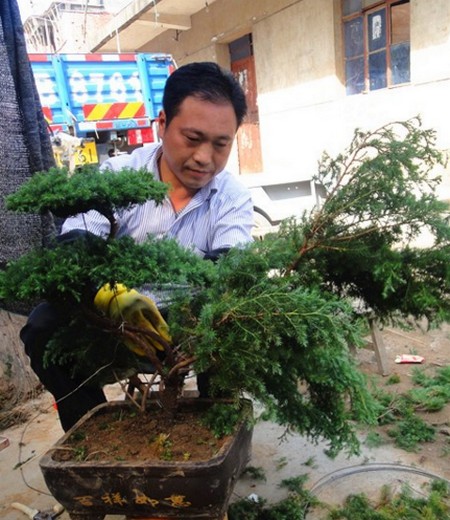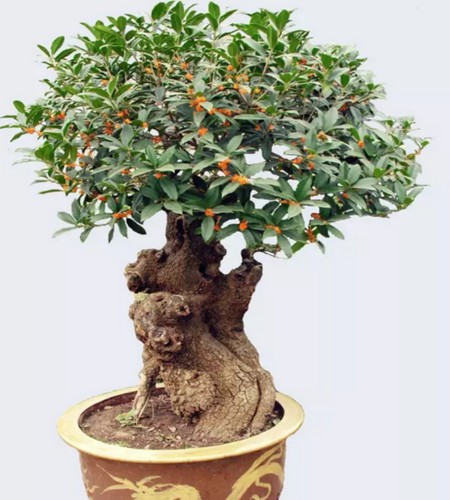Cultivation techniques of bonsai of Euphorbia angustifolia
The leaves of the flame spear are fiery red in late autumn and tall and straight in the rest of the season. it is a very beautiful ornamental plant with colorful leaves in autumn and winter. With its excellent bright red leaves in autumn and lasting for several months, it has been rated as one of the top-grade seedlings in the garden industry. The dense crown spear is full and neat in shape and resistant to pruning, so it is very suitable for making colored hedges.

Eichhornia crassipes is a cultivated variety with a flat crown. Leaves from oval to oval, serrated, simple opposite, dark green in spring, blood red or fiery red in early autumn, leaves will appear red earlier if the weather is dry, yellow flowers bloom in May-June, flowers light red or light yellow, Cymes. Flowering period is from May to early June, it is a very beautiful autumn color leaf variety, in acid soil, the color is better. Easy maintenance and management, strong adaptability, cold resistance.
Place: celestial spear is fond of light, should be placed in a place with plenty of sunshine and air circulation, and should be properly shaded in summer to prevent hot sun exposure. The light in autumn is beneficial for the leaf color to turn red as soon as possible. In winter, you can spend the winter outdoors and bury it in the sunny soil.
Watering: Wei Spear bonsai is usually kept moist, not dry, not watered, rather dry than wet. The spring and summer growth period should be properly watered to facilitate growth and blossom and bear fruit. When the leaves are red in autumn, the water should be deducted, and the basin soil should be slightly dry. During the dormant period in winter, it can be watered every 5-7 days.
Fertilization: Weimao good fertilizer, in the growing period every two weeks to apply thin rotten cake fertilizer and water. Give priority to phosphorus and potassium fertilizer and apply less nitrogen fertilizer to avoid futile growth. It is advisable to apply less or no fertilizer after autumn. Put some rotten cake crumbs in the basin as base fertilizer in winter.
Pruning: when new branches and leaves are produced in spring, they should be cut short properly to keep the crown dense and not scattered. Reshaping and pruning after falling leaves in autumn. Cut off germinating branches, overgrown branches and overlapping branches to maintain a certain styling tree posture.
Turn the basin: turn the basin every 2-3 years, preferably before sprouting and putting leaves in spring, or in autumn. When turning the basin, the long root system was trimmed, the old 1B2 soil was removed, the fertile and loose culture soil was replaced, and the appropriate amount of cake crumbs and rice bran ash were mixed. If the root is raised by culture, the plant can be gradually raised to expose the basal main root.
Prevention and control of diseases and insect pests: the common pests are long-shell insects, flat moth and yellow spot moth, so attention should be paid to the prevention and control. Shell insects can be controlled with 20 times of turpentine mixture, and diamondback moth and yellow spot moth can be controlled with 1000 times of omethoate or isocarbophos in larval stage. Euonymus is harmful to leaf-eating insects such as yellow poplar moth and yellow spot moth, and the control method is sprayed with 1500 times of trichlorfon or dichlorvos during the larval active period from April to May.
Time: 2019-05-25 Click:
- Prev

Transplanting technique of Pine Bonsai
People often say an old saying: people move, trees move to death. Therefore, it is necessary to pay more attention to the transplanting of big trees, otherwise it would be a pity to die in the process of transplanting. In the case of pine trees, transplanting large pine trees is also particularly important.
- Next

Causes and Countermeasures of non-flowering of potted Osmanthus fragrans
Osmanthus fragrans is one of the top ten traditional famous flowers in China, and it is also a good material for making bonsai. However, many sweet-scented osmanthus bonsai have not bloomed or rarely blossomed for many years. According to the habits of sweet-scented osmanthus and years of practice, the author analyzes the common reasons and countermeasures for the failure or lack of flowering of sweet-scented osmanthus bonsai.
Related
- Fuxing push coffee new agricultural production and marketing class: lack of small-scale processing plants
- Jujube rice field leisure farm deep ploughing Yilan for five years to create a space for organic food and play
- Nongyu Farm-A trial of organic papaya for brave women with advanced technology
- Four points for attention in the prevention and control of diseases and insect pests of edible fungi
- How to add nutrient solution to Edible Fungi
- Is there any good way to control edible fungus mites?
- Open Inoculation Technology of Edible Fungi
- Is there any clever way to use fertilizer for edible fungus in winter?
- What agents are used to kill the pathogens of edible fungi in the mushroom shed?
- Rapid drying of Edible Fungi

